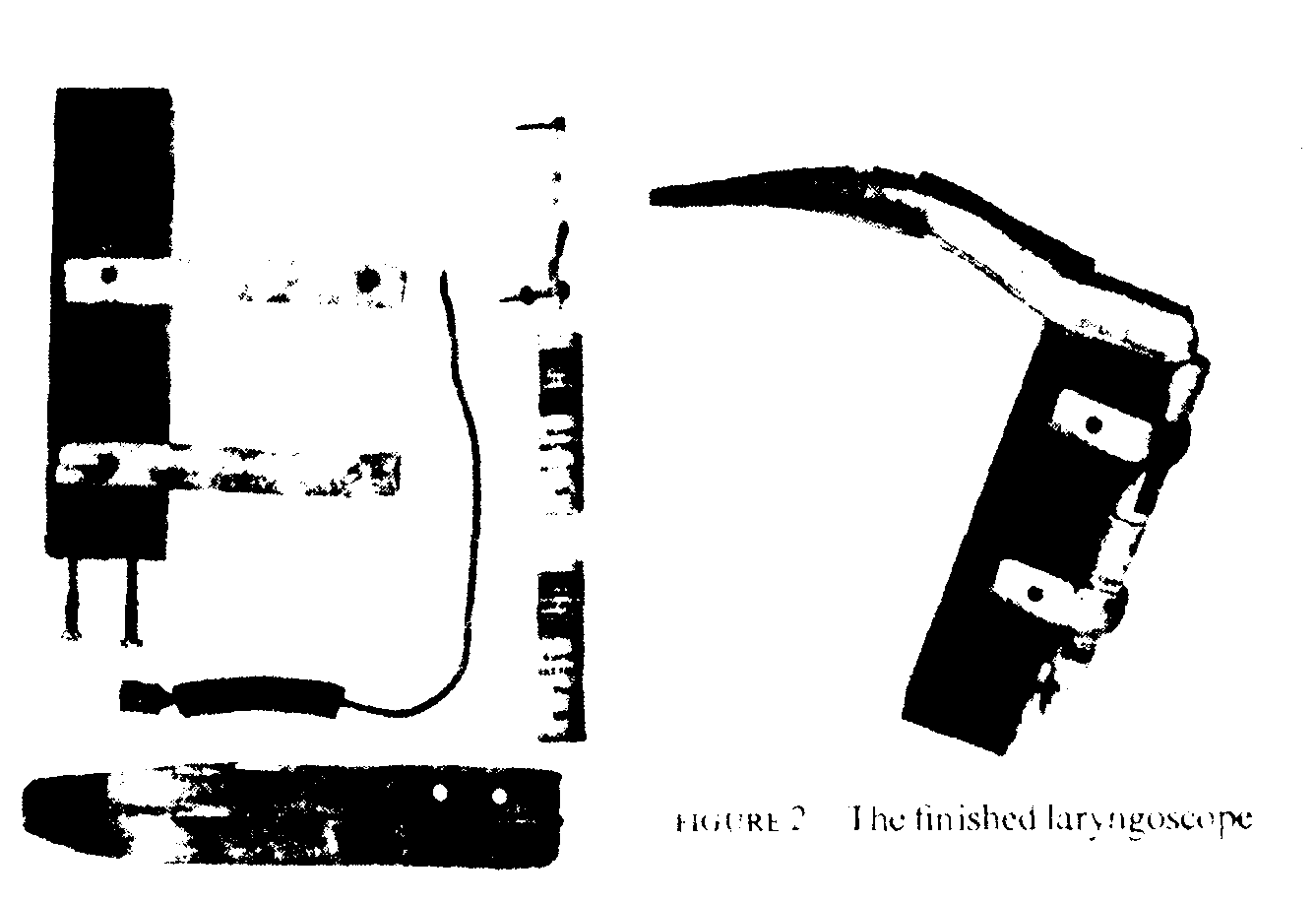In treating cardiac or respiratory arrest, the establishment of an effective airway and pulmonary ventilation is of the utmost importance. Although mouth to mouth respiration can he started without any equipment it may be ineffective or distasteful, for example with vomiting or pharyngeal bleeding. In these case; rapid intubation of the trachea is vital, but often precious minutes are lost while a nurse or orderly make a hurried trip to the operating theatre for a laryngoscope and endotracheal tube. Outside a hospital. the situation is even graver.
It occurred to one of us that an effective laryngoscope for emergency use could he made out of simple materials costing only a few shilling. After a number of attempts a suitable design was worked out, and ten of these instruments made in the hospital workshop. The low cost of this instrument or perhaps other models like it means that it can he provided for hospital wards and other departments more readily than the usual expensive type. It will be used infrequently, but needed quickly.

The handle is made of oak or beech, and two penlight batteries are attached by sellotape or by two light aluminium bands. At one end they are held by the blade. and at the other by a small piece of Perspex which bears s simple pivot switch. The blade is of twin track aluminium from which one of the three flangcs has been removed entirely, while the other two have been partly cut away towards the tip It is shaped by bending in a heavy vice.
In the track that is left there is an inexpensive pre-focused torch bulb with a lead soldered to it at its base. The rest of this track has in it some hard rubber tubing about this lead. and this stops the metal of the blade knocking on to the upper teeth or the gum when the instrument is in use. The bulb lies in a shallow hammered recess. The blade is held on to the wooden handle with two strong chrome screws.
The materials used to make this instrument cost less than three shillings in a retail shop. In a well equipped workshop an inexperienced person can make a batch of these instruments at the rate of two an hour.
Results of trial
To test the effectiveness and reliability of the instruments, they were used on patients requiring intubation during the course of general anaesthesia. One hundred such intubations were performed on unselected patients ranging in age from five to eighty-four years, with the following results.
Intubation was achieved on every occasion. In 88 of the patients this presented no difficulty. Of these. 47 were edentulous, 10 had no upper teeth, 26 had a full set of teeth, and 5 had awkward teeth with gaps.
The other twelve patients presented some difficulty, intubation being achieved with the aid of an introducer. Of these, eight had a full set of teeth, and one patient in this group required a second dose of scoline; three had awkward teeth with gaps, and one was edentulous with a slightly receding lower jaw. No post-operative complications were noted.
After each use, the laryngoscope blade was scrubbed with soap and water, and then immersed in 0.5% chlorhexidine in 70% spirit for five minutes. This in no way affected the electrical working of the laryngoscope. One instrument was used on sixty four separate occasions, being cleaned in the above fashion without detriment. In fact the illumination was unusually bright and most reliable.
AcknowledgementsA practical design would not have been possible without the advice of Dr G. S. Knowles, Senior Consultant Anaesthetist of the North Middlesex Hospital. Workshop facilities and help were given by Mr L. Small, Instrument Curator and his colleagues.
-o0o-
GillettsG.B. and Michael Patkin (1964).
Anaesthesia, 19, 595.
________________
One morning in 1963 I was doing a ward wound at the North Middlesex Hospital with my chief, Keith Moore, when a patient on the other side of the ward started bleeding heavily from his throat and died in a few minutes from suffocation.
A few weeks earlier he had some sort of head injury. A small traumatic aneurysm had formed in his throat, unnoticed until it ruptured without warning.
There was the usual kerfuffle to get a laryngoscope from the operating theatres one floor down. This was many years before the emergency carts of today.
That night I went home and made a rough model of a laryngoscope out of a piece of tin can and a piece of wood. I refined this and then learned how to use a milling machine and other workshop equipment. The curve of the laryngoscope blade was achieved by squeezing and hammering it between two pieces of curved hardwood.
I showed copies of it to the Royal Army Medical Corps in London and three went to South America via Sir James MacIntosh who said he liked the design. A trial of the laryngoscope was reported from the Christian Medical College at Vellore, India -- a huge teaching hospital there.
Attmept to get it made commercially failed, not surprisingly. It's not a bad instrument. The light was better than the standard laryngoscope. I used to show how robust it was by flinging it against a wall and shoing it would still work.
Brian Gillett was the anaesthetist I worked with most often. He went on to become a consultant anaesthetist at St. Bartholomew's Hospital
It was fun learning to use the big machines in an engineering workshop. I could only manage simple items (unlike, say, Heifetz, the Los Angeles neurosurgeon - and brother of the famous violinist - who had a workshop in his home and developed items such as his eponymous micro-vascular clip.
-o0o-